How to plan the interior of a bathroom combined with a toilet?
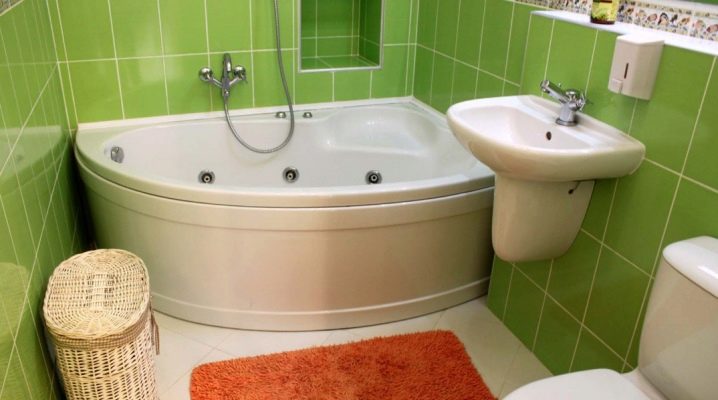
Bathroom planning involves a number of requirements. First of all, it must be functional. However, when a bathroom is combined with a toilet, the list of underlying factors increases. In order for the room to meet all the stated requirements, it is necessary to properly plan its interior, taking into account the peculiarities of combination, repair, decoration and decoration, as well as the arrangement of furniture.
Peculiarities
A bathroom combined with a toilet is a combination of two separate rooms in terms of functionality. Previously, this was one of the problems of small-sized city apartments. Due to the lack of usable space, there was barely enough space for placing a bathtub and toilet. You didn't even have to think about the washing machine: often a place was prepared for it in the closet or corridor.

The problem of such rooms still exists today. It is aggravated by the insufficient height of the ceiling, broken perspective, the presence of incomprehensible protrusions that do not carry any functional load. Often, the place for the bathtub and toilet is extremely inconvenient. Moving around inside such a bathroom is difficult. The list of inconveniences is completed by a narrow doorway, the side of the door opening and the inconvenience of approaching it.
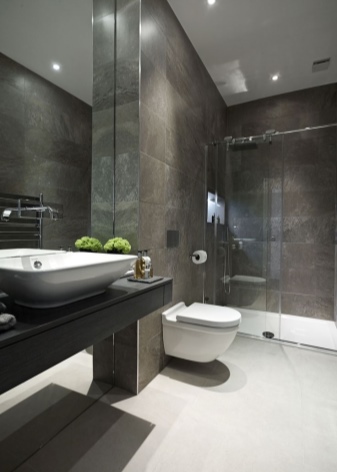
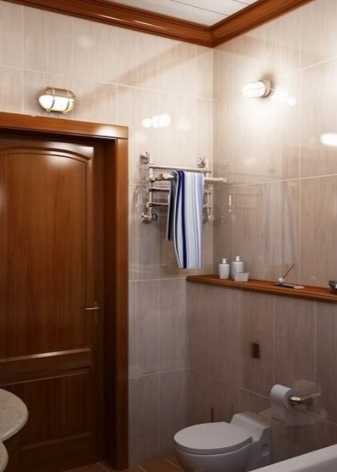
However, perspective is not the main factor. The supply of communications is important, as well as the degree of humidity of the two rooms. The bathroom is a room with a high level of moisture. Condensation often appears here, the load on all components of the interior is significantly increased. Ventilation must be carefully thought out.

Due to the connection of two rooms of different functionality, a kind of differentiation of zones hazardous in terms of moisture level occurs. For the toilet area, this is fraught with the fact that the toilet may be wet. His tank will almost always be wet on the outside. Too much condensation will cause water to drain onto the floor, which can damage the structure of the floor covering over time. For this reason, for surface cladding, you will have to buy materials with maximum resistance to moisture.

The combined bathroom determines the set and size of furniture, the type of decoration for walls, ceilings, floors. The location of the storage systems and accessories depends on the location of the bathtub, washing area and toilet bowl. One of the positive aspects is space saving, which is especially true for apartments with a lack of usable space. Due to this, it is possible to give the environment ergonomics, practicality and a certain comfort.

The absence of a wall reduces repair and surface finishing costs. There will be no second door either. Savings will also affect cleaning products and cleaning time. However, the most positive nuance is the possibility of masking communication systems. This is often difficult to accomplish in a toilet environment due to the reduced floor space.

From an aesthetic point of view, the combined bathroom has more possibilities for interior design. Today, there is a tendency to give the bathroom the appearance of a living space for a certain style, expressing the inner world of the owners of the house. Modern units are more like rooms adapted for bathrooms and toilets.The position of exceptional functionality without aesthetics is outdated.
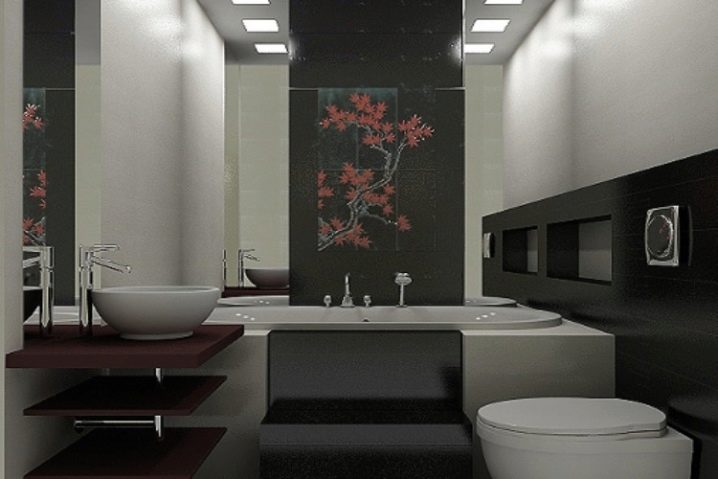
In such rooms, furniture is installed for storing hygiene and other accessories, dressing tables, benches, chairs, dressers with mirrors, wardrobes. For the convenience of all family members, sinks are equipped with two sinks, a bidet is added. Non-standard solutions are distinguished by the presence of household appliances. Usually it is built into niches, which are used depending on the layout, including for the hidden location of washing and drying machines, as well as baskets for dirty linen.

Connecting two rooms frees up space for accessories. Today it is customary to decorate bathrooms with fresh flowers in vases, placing them on dressing tables or niche shelves. An extraordinary technique is to decorate the wall with a clock or a panel. A look at the arrangement of the bathroom adheres to the importance of the aesthetic component. Comfort is conveyed through the texture of all elements, including finishing materials, their color, effect, compliance with the conceived idea of style.

An interesting solution to masking structural elements is to use columns as supports. Space is freed up, with the columns supporting the ceiling structure and allowing the use of framing systems. The demolition of the wall allows you to make the bathroom as functional as possible, when there are enough free centimeters to install a cheap cabin.

Separately or jointly - which is better?
Separate bathroom and toilet layouts often do not follow the general concept. It does not oblige to select the same type and color of finishes for wall, floor and ceiling ceilings. There may be various plumbing accessories (fixtures, valves). However, when two rooms are connected into one, the situation changes. You have to combine the toilet, sink, shower and bath in a single style. This is an obligatory match of texture and shape.
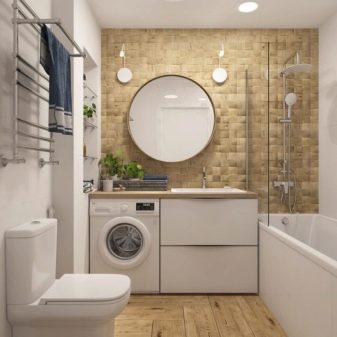

For a toilet, combining with a bath cannot be called the best solution. We'll have to abandon some types of material that can be used for isolated rooms. For example, it is undesirable to use paint, even if the manufacturer claims its durability and flawlessness. In conditions of constant exposure to moisture, it will quickly move away from the surface. Some analogs are completely erased during cleaning, which casts doubt on their relevance.


For the bathroom, the neighborhood with the toilet, on the contrary, is relevant. This is often associated with piping. When two rooms have one riser, it is convenient. It is not necessary to run pipes for several meters, many joints and unnecessary bends can be eliminated. However, this applies to cases where the bathtub and toilet are located near the riser.


Combining a bathroom and a toilet is sometimes a necessary measure when building a building. For example, if there is not much space for construction, it has to be left for other needs. This is especially true if the house is being built for a family. In this case, you have to think over the degree of convenience at the stage of designing rooms.


However, not everyone likes the combination. Often this is due to unpleasant odors, the simultaneous use of the premises by two family members. In addition, the wall divider can be load-bearing. Self-connection is accompanied by a bunch of necessary documents and approval, taking into account the requirements of the regulations.

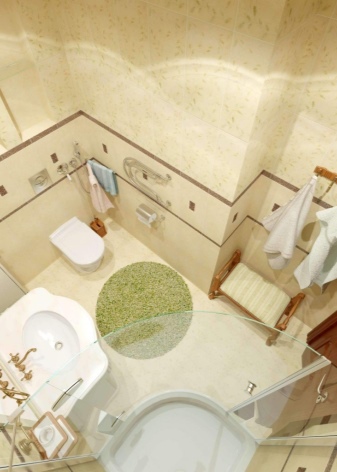
Combining a bathroom and a toilet allows you to install standard furniture in the room. Often, a shared bathroom allows you to efficiently use the space. The meters that are taken away under the toilet (distance to wall ceilings) can be used to install a rack, shelf, cabinet or washing machine. In each case, the choice of furnishings is individual. In general, the combination can be called the best option for using the space of the home.

Combination options
The fundamental factors of each combination are 3 zones: washing, taking a bath (shower) and toilet. Wiring diagrams of engineering communications are important. Everything else is auxiliary moments of arrangement, whether it is a joint bath with a toilet in a panel house or a private building. This is necessary when three or more people live in the apartment. The layout can be different (together with a shower cabin, without it, only a cabin). The correct option is the one that meets the regulations and user convenience.

For example, you can install a bathtub against the wall opposite the entrance, fix hanging furniture with a sink on one side. A wall-hung toilet can be mounted near the bathtub.

If a bathroom is not provided, the shower area can take its place. The arrangement of furniture can be linear. One wall is left practically empty (with the exception of the heated towel rail). On the opposite side, a table with a sink and a mirror are installed.

The bath can be located along the wall at the entrance. Then the toilet can be arranged opposite the door. The washing machine should be installed on the wall opposite to the bathroom.
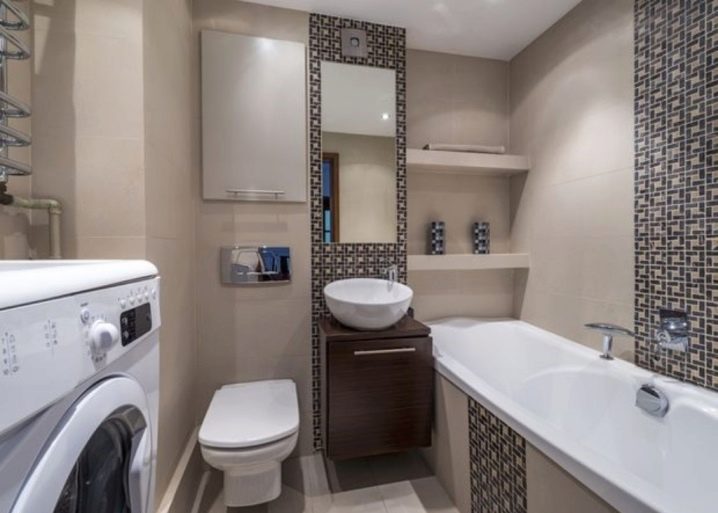
If the valuable centimeters of the area are very small, you can do with an angle shower instead of a bath. It is better to fix the toilet nearby. For a sink, you should choose an elongated shape.
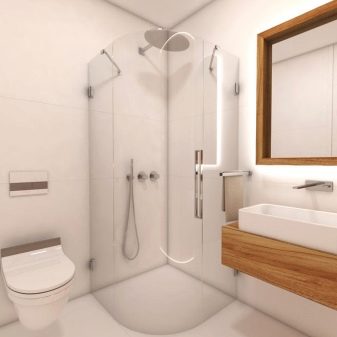

If there is a niche in the room, it is worth using it for installing a washing machine and hanging boxes. Then the toilet can be placed in the corner, and the compact-sized bathtub can be placed next to it.


If the room is spacious, you can use the partitions technique. For example, the separation of the shower and the sink area will be successful. The toilet can be isolated by placing it further away.

When you want to install a bathtub and a shower stall at the same time, you should use the corner options. One corner is closed by a bathroom, the second by a cabin, a toilet and a sink are placed on both sides of the bath and shower.

In a confined space, you can install the sink and bathtub against the same wall, fixing the toilet on the side of the adjacent wall in relation to the sink.

Area dependence
It is no secret that it is the area that sometimes sets a rigid framework for the placement of plumbing and furniture. When footage is limited, the comfort of the interior is questioned. The difference between the dimensions of a very small space, say, 2 - 4 square meters. m and a room of 5 - 6 sq. m is obvious. You cannot put a closet or even a small cabinet here for the necessary accessories.


In small apartments, the comfort of the tenants is not thought out. The bathroom may not be enough for an overweight person. Sometimes the width of the doorway to the shared bathroom is 60, at best 70 cm. It is difficult to choose the size of the bathroom in a small apartment, because you have to think over the location of the toilet so that it does not interfere. There are two options: demolish the wall or change the bathtub to a shower stall. The shower design will free up valuable centimeters.

In a confined space, you have to do with a heated towel rail, which is mounted mainly to the wall in a free space. It is not very convenient, but functional. You can always hang a bath towel, bathrobe, linen on the crossbars. In tiny bathrooms, such devices are attached to the door.

In a large joint room, in addition to functionality, comfort is felt. Starting from 6 m2, it is already possible to arrange a free wall with a cabinet with drawers or a pedestal on legs. If there is a sink with a sink here, you can make a screen, buy furniture with a stone countertop, hang a mirror in a frame on top. It's even better when there are small niches on this wall. They can be used for storing hygiene products or towels.



Design
Drafting a combined bathroom project is subject to a number of requirements. If it is carried out at the time of the construction of the house, they try to choose the best way to construct load-bearing walls.Designing will allow a more rational approach to the issue of communications. Due to it, it is possible to organize the supply of water and electricity in the most convenient way, without violating the aesthetic side of the issue.

Make up a design project. It indicates the exact dimensions of the combined room, schematically applies the location of each object, including shelves in niches and accessories. This will allow you to better see the future interior, assess the degree of convenience in the location of furniture and plumbing. For a more visual method, special computer programs are used. Due to the introduction of the required footage, the designers allow you to draw up several types of design at the discretion of the customer.

Design allows you to evaluate the ergonomics and convenience of the interior composition, choose the best option, taking into account the freedom of movement. It will also clearly show the location of the lamps, their distance from hazardous areas (60 cm or more to the sides of the bath, a height of about 2.3 m from the floor). At this stage, the total power is calculated so that the lighting of the combined bathroom is sufficient.

Convenience of work of designers is taking into account different forms of premises. In the program, you can see how best to compose the interior of a rectangular, square, oblique perspective of the space. The layout of a narrow bathroom combined with a toilet is especially relevant. It is usually linear in such cases. For example, a toilet with a bathtub is placed right next to one wall.

It is much worse when the layout is not initially combined in the best way. Sometimes, when entering such a bathroom, an ordinary person can see a corner bathroom that barely fits into the length of the wall. Often there is no room left for washing in this case. For the toilet, a zone is allocated that creates discomfort when moving. The design of this option provides for the adjustment of the room with the best placement of the necessary plumbing elements.

Repair
Renovation of a bathroom, implying its transformation into a cozy space for hygienic and natural procedures, implies calculating the amount of finishing materials, their correct purchase and use. It is important not only to buy quality cladding suitable for bathroom decoration. What matters is its aesthetic relevance. For example, the abundance of one finish will make the bathroom interior boring.

The texture gets expressiveness only when comparing. Therefore, the walls, ceiling, and also the floor are trying to finish with raw materials of different colors and patterns. The location of the finish matters. The best approach, according to stylists, is to highlight functional areas with finishing material.

The more creative the material, the more moderate its use. For example, when highlighting a wall with a brick texture, you have to abandon the mass of accessories. Typically, this design implies a minimal option for decorating the bathroom. Other walls will have to be smoothed, for example, with plain coatings without a pattern at all.

Finishing
The range of finishing materials for the design of the combined bathroom is diverse. The priority is given to certain types of raw materials, subject to the list of developed requirements related to the conditions of the bathrooms.
Several are especially relevant.
- Resistant to moisture. The material should not let it pass through the structure to the enclosing structures.
- Environmental friendliness. The priority is cladding without harmful components that can harm the health of households.

- Antistatic. The best choice is considered to be a finish that is resistant to the formation of an environment for the appearance and growth of mold fungi.
- Strength. The selected type of facing raw materials should not suffer from accidental mechanical stress.
- Compatible with any type of lighting fixture. The material should not melt when the lighting device is used for a long time.
- Refractoriness. Wall, ceiling or floor surfaces must not sustain combustion in the event of a short circuit.



- Optimal weight. Cladding products with a large weight create additional load on the carriers. In some cases, this becomes the cause of deformation of the floors.
- Durability. Renovation in the bathroom with toilet is not done often. The coverings must adhere firmly to the foundations of the ceiling, floor and walls.
- Fade resistant. The priority is to finish with a protective layer that does not allow the tone to become faded.
- Ease of maintenance. The coating should be cleaned with clean water and a cloth (sponge).


- Resistant to abrasion and chemicals. The best finish is one whose surface remains unchanged with frequent cleaning, including the use of household chemicals.
- Aesthetics. The priority is to finish with a pleasant appearance.
- Availability. The best material is the one that the average buyer can afford.

Types of finishing materials
Most often, wood, plastic, reinforced glass, tiles, mosaics, moisture-resistant drywall and stretch film are used in the arrangement of combined bathrooms. Each type is characterized by its own characteristics and service life. The wood is treated with water-repellent impregnations. This avoids delamination of the structure.



Drywall
Plasterboard sheets are used mainly in spacious bathrooms combined with a toilet. GCR is characterized by form compliance. Due to this, you can create any shapes from it, in addition to the traditional box. It is used for arranging the ceiling, the construction of partitions, remote from hazardous (wet) zones. It is thick enough to hold decorative elements and even thin tiles.


This material is quite fragile. You need to work with it very carefully to avoid dents during installation.

It is a good basis for various finishing materials. Compatible with any type of lighting fixture from pendant and near-surface to spot and fiber optic.

Stretch film
The best option on the basis of PVC for decorating the ceiling space. The film perfectly retains water in the event of a leak from the apartment on top, is easy to clean, has a matte and glossy type of texture. It is not subject to degradation from condensation, and supports the installation of luminaires of any kind, including fiber optic and tape. Due to a special technology, it can have a pattern on the surface.



This allows you to convey the desired atmosphere and hint at belonging to a particular style of interior. Photo printing is performed to order according to an individual picture processed in a graphic editor. The finish is durable, does not lose saturation and purity of shades, and is environmentally friendly. The disadvantage is the need to warm it up and place it before pulling it up to 60 degrees. This can be done by means of a heat gun, which the ordinary head of the family usually does not have.


Tile
A versatile material for decorating walls, floors and ceilings. Differs in thickness, size, shape. On sale it is sold mainly in the form of geometric shapes. With regards to the ceiling variety, it may have a wavy edge, the appearance of an octagon. The gluing of such a material implies a seamless fixing technology.

Wall options are able to reproduce an unusual texture. Due to the unusual shape and heterogeneity of the thickness in different parts of the element, cladding with imitation of facade materials is possible. Floor materials are distinguished by their greater thickness and resistance to weight and mechanical loads, as well as vibration of washing and drying machines. Perfectly combined with mosaics and epoxy-based self-leveling three-dimensional floor inserts.

Mosaic
Reduced tile interpretation. It can be ceramic, rubber, glass, stone, differs in a variety of textures. It can be glossy, matte, mirror-like, transparent, imitating gravel, cork, stone. On sale it is presented in two categories: traditional and mesh styling.In the first case, it is laid in a modular way, part by part.






The second version is nothing more than a mosaic glued onto a grid. It is easier to glue, there is no need to align the seams between the elements. This saves time for surface finishing. The disadvantage is moderation in use. When there are a lot of mosaics in the interior of the bathroom, it creates emotional tension and becomes tiresome for the eyes.






Panels
There are wall and ceiling. Depending on this, they are made of plastic, metal, glass, wood. For the ceiling, derivatives of wood and plastic are used. If cassettes are used for the frame, they can be made of thin metal sheets with mirror inserts.


Polyfoam is not suitable for ceiling decoration. Its structure allows moisture to pass through, which is associated with deoxidation of the glue. Varieties for walls can be siding for interior decoration and wall panels of different widths. The connection provides for locking technology.

Reiki
The material of manufacture is plastic. Reiki differ in different widths and wide imitation capabilities. They go well with drywall, can be used to decorate the surfaces of walls and ceilings. Depending on the evenness of the wall and ceiling ceilings, they can have an adhesive or frame installation technology.


The glue method is used when the space of the combined bathroom is limited to a minimum. The frame system reduces the distance from the wall to the rail by 10 cm on average. The technology can be sutured and seamless. Externally, both have joints, only differ in width (for seamless, there are fewer gaps).


Glass
This raw material is not essential, but it is often used as shower curtains, shelves and furniture fronts. It has a reinforced look, it can have a traditional transparent, mirror or painted type of design. It is used to decorate the ceiling with a kind of cassette tiles with a lock connection technology. Looks stylish, expensive, has the ability to make any interior light. The disadvantage is the visualization of lime stains left on the surface from moisture.




Color and nuances of the combination
The choice of shade for the design of the combined bathroom depends on the taste preferences of the customer, the footage of the room, its degree of illumination, the effect of color on perception. Modern professional interior designers are able to reveal the beauty of every tone of the color palette. A creative look allows you to combine bold contrasts, related tones, making the bathroom interior multifaceted. An inept combination often looks rustic, so the choice of tone must be thorough.

Conventionally, the collection of paints can be divided into 4 lines:
- neutral;
- natural;
- pastel;
- saturated.



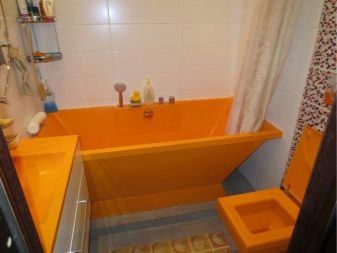
All directions are distinguished by the purity of tones, their softness and a certain muffledness. Neutral décor is popular, but predominantly in a spacious room. When there is not enough space, it will tend to be limited, a kind of hopelessness. Of course, you can try to change the atmosphere with the hygiene items of the color palette. By itself, such a design is devoid of emotional coloring. The way out of the situation is to add woody tones, as well as the color of juicy greens and olive.

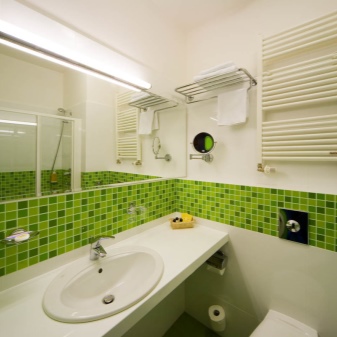
The natural range is in the spotlight today. It can be seen in every branch of interior design. It is used in wall decoration, bath screen tone, its decoration, toilet lid or decoration, shower stall cladding. Floor cladding is a traditional technique for infusing woody tones. Less often, it can be seen in accent points zoning the combined bathroom (niches, ledges, mirror zone, color of artificial stone countertops). The most popular shades are dark and bleached wenge and sonoma shade.Mixes of light gray with beige are popular, as well as a combination of black and brown colors.



The pastel range is one of the usual solutions. Along with traditional marine colors (blue, turquoise, blue-green), mint, peach, bleached coral and terracotta shades are added to the palette. Look good in the interior of the combined bathroom in olive, milk, cream and beige tones. When added gold or bronze, they look elegant. An ivory shade is in demand, as well as a pearl tone with a light mother-of-pearl.




With regard to the rich colors of the palette, the combination is special. Today it is customary to combine them softer. For this, a binder color is used. For example, a light gray color will help to combine together black and terracotta tones. Wine (orange) with white looks harsh, but adding creamy golden will soften the perception. Gold can dilute a mix of woody and black. Silver will enhance the contrast between purple and black.




Particular attention is paid to the naturalness of the tones. When choosing a certain texture, it is especially important that the shade looks natural. It should reproduce imitation of marble, stone, brick, concrete, lime, malachite. There should not be any acid and screaming in the tones. This trend is outdated, the focus is on the nobility of any shade or the right combination. You can use up to three different textures in one design. In this case, the main color can be related, and the degree of saturation varies.




Lighting
Depending on the footage of the room, the height of the ceiling, the presence of protrusions, partitions and niches, lighting is also chosen. Often times, the central luminaire in a shared space is not ideally located in the center of the room. This disadvantage has to be compensated for by means of compositional lighting. It is a combination of ceiling center lighting and auxiliary lighting. Combined lighting can be located on the ceiling and walls.

Since high demands are placed on light sources for the bathroom, LEDs are more often used. They are harmless, do not flicker during power surges, and are designed for a long service life. Unlike analogs, diodes do not heat up; they convert almost all consumed power into light. With a minimum of power consumption, they shine brightly, but directionally.

Limiting the direction of the light flux is associated with the formation of dark spots. It turns out that only the area under the lamp is illuminated. To illuminate the entire area of the combined bathroom, it is necessary to additionally apply auxiliary lighting, often placing it with an equal pitch between the spotlights.

Some luminaires have a tilt adjustment system. This is especially useful when you need to light up a mirror or dressing table. Sometimes, to solve this problem, mirror canvases with built-in illumination around the perimeter are bought. In another case, a backlight is attached above and below the mirror for uniform illumination. If this option is not possible, buy two identical wall sconces and attach them on both sides of the mirror at the level of the middle of the side faces.

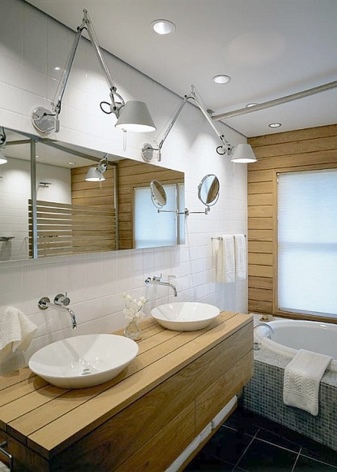
The main purchase rules are the closed type of shades, durable materials, safe light sources. Guards to prevent the lamp from breaking are encouraged. Good options are LED panels, spots, reflector lights, and flexible LED strip. Number of LEDs per sq. m should provide a soft, but sufficient level of luminous flux.






Decor
Decorating the space of a bathroom combined with a toilet, carried out in several ways:
- by means of compositional lighting;
- due to the same plumbing finish;
- reception of panels and accentuation of individual functional areas;
- through the texture of the selected material;
- through accessories;
- by the method of indicating belonging to a certain style of interior.



With the right and deliberate approach to interior design, you can use several decorating techniques. For example, plumbing should create the illusion of an ensemble anyway. This should be reflected in the same roundness, shape, color and matt (gloss). Can be completed with silver, chrome valves, tank button, spout and shower.


The background wall decoration should not merge in color with the plumbing, otherwise everything will merge into a single color spot. The material for highlighting the bathtub, sink and toilet bowl should have as little relief as possible. This will make it easier to maintain the coatings. It is better to decorate the thresholds with a contrasting color. Their accentuation will eliminate stumbling upon entering the combined bathroom.


The tiles are selected based on the size of the room. If it is small, the dies should be smaller. In this case, it is better to choose a light grout, so as not to visually divide the room into many parts. No extra variegation is needed: a single-color coating will be enough. Dark tones are not suitable here: they will visually make the interior heavy and uncomfortable.

For the floor, choose porcelain stoneware or ceramics of a muted color. A good solution would be to buy marbled tiles, planks, parquet. If you want novelty solutions, you can design in the form of a carpet. This will allow you to beat the most walkable area. For example, you can lay out a drawing near the bathtub, frame its edges with a border, and make the rest of the area with a plain material.



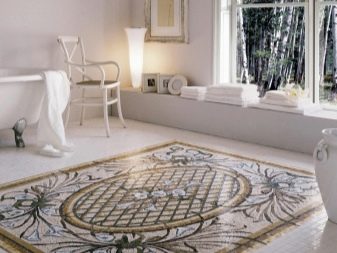
The design ideas are different. You can combine floor tiles with epoxy floors. An accent with photo printing, framed by tiles around the perimeter, will look unusual in such a room. You need to place such an accent in an open place where there will be no furniture or plumbing.




It is better to choose furniture after finishing work. The interior can be made stylish based on fashion trends. However, if the details of the furniture are already there, the decor is adjusted to suit them.
For example, a stylish solution is the imitated texture of cladding imitating wood, painted board, stone, brick and even concrete.

It is better to decorate the shower stall area with smooth tiles. For the floor, it is preferable to purchase material with anti-slip and matte texture. Ceiling material usually smooths out the abundance of tiles or siding. Its decoration will be backlighting, including RGB class. The ability to change colors will allow users to immerse themselves in any atmosphere they desire.

Furniture
Bathroom furniture is selected from materials that are resistant to moisture. Usually, products are installed from certain grades of solid wood, as well as plastic and metal. Not suitable for arranging a bathroom combined with a toilet, products from MDF and fiberboard. Under the influence of steam, their structure is destroyed, which shortens the service life. The wood is treated with special antiseptic and water-repellent impregnations.


Most often, such products are installed as far as possible from the bath, shower and sink area. In the shower room, they think over the ventilation system, additionally separate the space with glass curtains. This protects the furniture to some extent from destruction. Sometimes the set is mounted in a niche, which frees up space for movement around the room and protects from accidental bruises.


Usually, in the design of the bathroom, they try to use a cabinet, a chest of drawers with a mirror, a wardrobe or a rack. If there is very little space, they get by with shelves. Ideally, these are glass shelves mounted in niches. A curbstone with legs is convenient because you can remove a lot of items, including detergents, into it. This helps remove the visual sense of clutter by hiding a ton of small details inside.

When there is enough space, a dressing table is installed in the room. It can be a stand-alone product or part of a custom-made furniture ensemble for a bathroom. Usually chairs become an addition to such a wall.Sometimes the arrangement includes benches with comfortable backs, and sometimes armrests. They allow you to rest after your bath.




One of the unusual pieces of furniture is a bathroom stand. She helps older households get into the bath, because often at this age, movements are limited. The product can be made in the form of a ladder. Rarely is a washing machine mounted in modular furniture. The modules themselves are convenient, they allow the purchase of only those parts that are suitable in a particular case. However, they are not suitable in every case due to the non-standard layouts of the combined bathroom.

Ready-made projects for inspiration
You can evaluate the possibilities of the designer's professional view of the combined bathroom by referring to the examples of the photo gallery.
A combination of gray, brown and bronze with a contrasting wine insert in one of the zones. The plumbing fittings are designed in a single design. The dark tones are softened by the white ceiling and furniture.


A creative approach to dividing functional areas. Combination of white and brown, use of a single chrome finish. Separate lighting accentuates every functional area.


Scandinavian style with its inherent ease. Combination of white with dark and light woody contrasts. Stylish design solution for a bathroom with a small window.
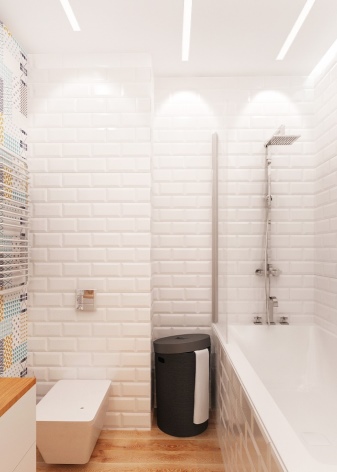

Engaging one side under the shower stall and toilet seat. Using a different texture to highlight each functional area. Identical metal fittings for bathroom fixtures and accessories.


Rational layout of the room with a broken perspective. The combination of gray and brown looks stylish, the white background of the bath, sink and ceiling brings light spots to the interior. An expressive solution, complemented by unusual lighting fixtures.


A stylish solution for a small shared bathroom. The use of neutral tones and different textures is softened by the warm light of wall and ceiling lighting.

Not quite practical, but rather unusual bathroom design. Using different materials for wall cladding and shower floor. The original installation of furniture near the bath, metal fittings for plumbing in the same style.


An example of mixing matte and glossy textures. A rational approach to arrangement in a confined space. Using a separate lighting for the sink area.

When drawing up an interior for a specific room, it is difficult to completely copy the finished project. This is not necessary, because everyone's internal perception is different. Trying to reproduce someone else's example will not always lead to comfort. In addition, stores are unlikely to have identical cladding and furniture, and the budget often does not coincide with the desired one.

You can take the principles of the layout of the toilet, sink and bath as a basis for placement. It will not be superfluous to build on the methods of choosing a color, taking into account the footage, peering into beautiful pictures. These are the basics, with the help of which it is easier to understand and choose the best option for decorating your own space. Sometimes examples can help you avoid tearing down a wall between two rooms. This is not permissible in every case: sometimes the removal of the carrier causes the wall to sink.

You can watch the combination of a bathroom and a toilet in this video.













The comment was sent successfully.